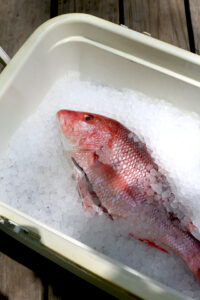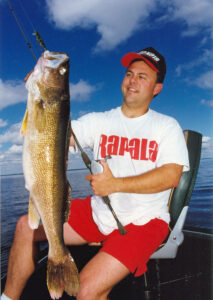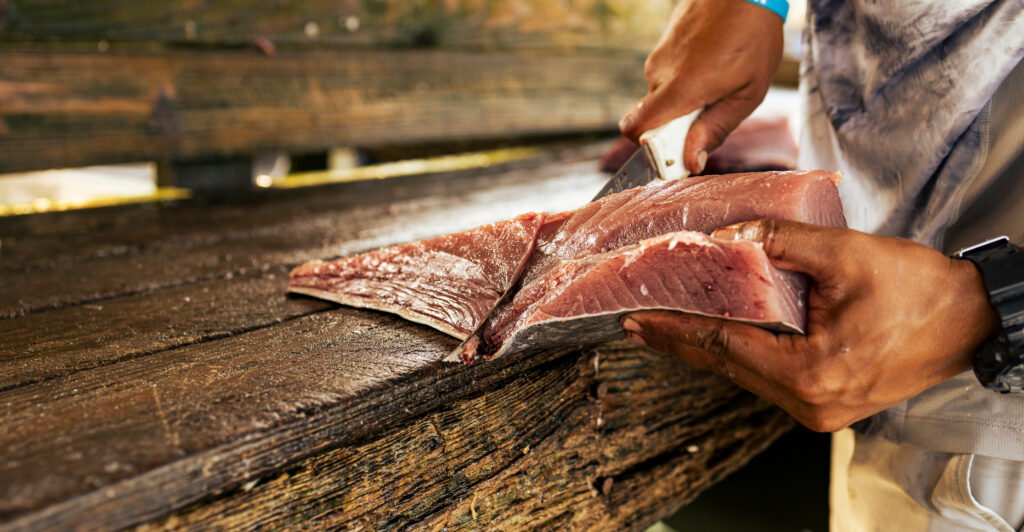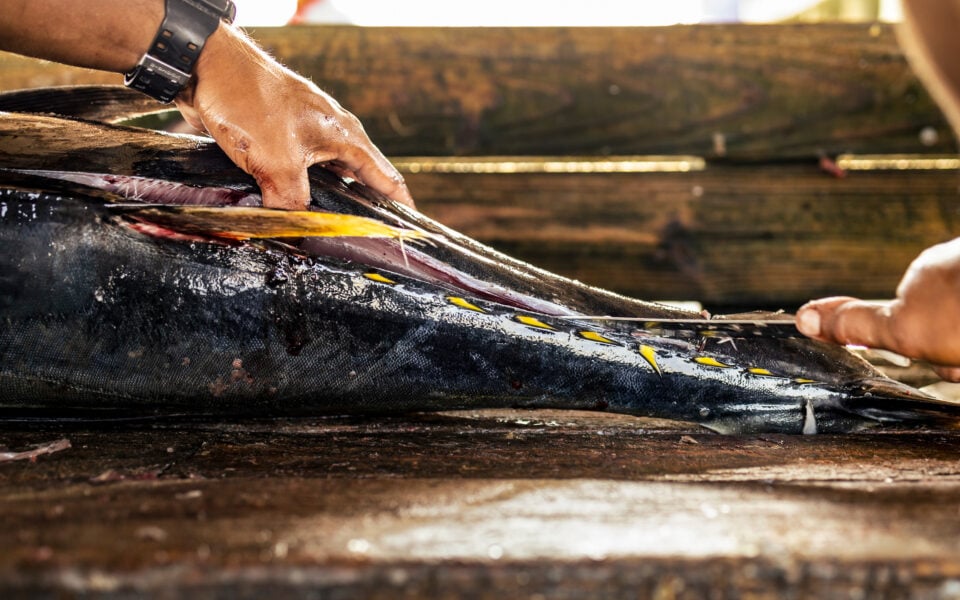“Fresh fish” is synonymous with “summer” in my view. What better way to spend the days than with a fishing pole in hand surrounded by family with the anticipation of a great catch ahead and a tasty meal to wrap up the day?
Our family enjoys every kind of fishing, but especially deep sea fishing. We try to go on a deep sea fishing trip at least once yearly to stock the freezer with seafood until the next year when we do it again. Thankfully, we have many lakes and creeks around our community to catch bass, bream, catfish, and crappie for fresh water fish options.
I’m all about making the most of any harvest. With the limitations on most species and the hard work and planning that goes into your fishing adventures, the last thing you want to do is allow your catch to be anything less than amazing at the table.
With a few “fish care essentials” your catch will not only taste superior, it will retain the nutrition and health benefits that doctors recommend we consume at least twice each week. It will be easier to handle, in that it won’t be slimy and will be easier to prepare because the fish’s flesh will still be firm.
Icing Fish

Stacy Harris
“Icing fish” is the best way to keep fish fresh and is the most important step for optimal flavor and texture in seafood. Cool the meat down as soon as possible to keep the flesh firm and fresh tasting.
-
Fill a Cooler or Fish Bin with Ice
Saltwater ice is best for saltwater fish (we’ll talk more about freshwater fish below). Heat and air are the two main opponents of keeping fish from decomposing. By keeping them on ice you are addressing both issues. Crushed ice is best because it surrounds the fish. More surface area has direct contact with the ice and cools the fish more completely, keeping the fish colder than blocks of ice would. Regardless of the type of ice, cool that fish down!
A good rule of thumb is two pounds of ice should be added for every pound of fish. Fish and ice should be mixed as evenly as possible in the cooler.
-
Dispatch the Fish ASAP
Dispatch the fish as soon as you pull them into the boat with a stick or a club and immediately put it into the crushed ice. Keep the drain open on the cooler if you are able so that the fish is not sitting in water and continue to add ice to the cooler or bin.
For freshwater fish, if your boat is furnished with a livewell, this will be the best way to keep your catch for the time being. This way they’re alive as long as possible. If you are in rough water or the livewell gets too crowded, you may be better off dispatching your catch sooner than later and icing them down. You don’t want the fish to be starved for oxygen or get beat up riding in a rough chop when in the livewell. Most freshwater species have delicate flesh that deteriorates quickly.
If you’re plan is to keep fish on a stringer, if the water is cold this may be OK. But even when fish are kept on a stringer, they begin to deteriorate because of stress. If the water is warm, regardless of whether you’re using a stringer or a livewell, it is best to dispatch the fish as soon as possible, get the guts and gills removed and get the meat cooled down ASAP.
-
Clean the Fish
As soon as you are able, remove the gills and internal organs and place the fish back into the crushed ice being sure the cavity of the fish is filled. The ice should be replaced every few hours if you’re out for a long day. Don’t let your fish soak in water for long, even if it’s ice-cold water. This will soften the flesh and eventually you’ll have a mushy fillet.
Refrigeration

Todd Amenrud
You can store the fish in your refrigerator in crushed ice for 3 to 5 days. The flesh will deteriorate slightly each day. Large and lean fish store better than small fatty fish.
-
Rinse
Rinse the fish in cold water then pat dry with towels.
-
Wrap the Fish
After patting dry with paper towels wrap the fish in plastic wrap and place in crushed ice. It is still best to store the fish surrounded by crushed ice because the cooler you can keep the fish, the better. If you don’t have crushed ice, put the fish over ice cubes in the bottom of a bowl. Place a zip-top bag of ice cubes on top of the fish.
-
Replace the Ice Regularly
Drain and replace ice often to ensure the fish is staying cold and is not sitting in water which will cause the fish to get mushy.
You can make your own draining container by purchasing two Tupperware bins the same size. In the bottom of one of the bins make drainage holes. Place the container that has drainage holes in the one without them. The melted ice will drain through and the fish will not sit in water.
Freezing Fish
Again it is important to note that heat and air are enemies to the quality of fish. Fish will last in the freezer from three to twelve months. There are several ways to freeze fish. Depending on how you have cut or not cut the fish either fillets, steaks, chunks or whole will dictate how you choose to freeze or preserve your fish.
-
Freezing Whole Fish
All fish must be gutted and scaled before freezing. Once gutted and scaled, rinse the fish with very cold water and vacuum seal or store it in a zip lock bag removing as much air as possible from the bag. Whole fish can also be frozen by using the ice glazing method.
Freezing is an excellent way to preserve freshness in your seafood and fresh water fish. Lean frozen fish will keep for about 6 months. Lean fish is fish having less than 4% fat such as walleye, pike, snapper, grouper, and whiting. Fatty frozen fish, which has more than 4% fat such as salmon, tuna, halibut, mackerel, mullet, and trout will keep for about 3 months. Shrimp will last for about 3 months as well. Actually the fish can last longer, but the quality will decline quickly and your catch will be susceptible to freezer-burn.
-
Freezing Submerged in Water
Fillets are often very suitable to this method. Rinse the fillets in salty ice water. Fill a zip top bag with salt water if saltwater fish and tap water if freshwater fish and submerge the fish fillets in the water. Seal the bag and place in the freezer. Shrimp are excellent frozen using this method.
-
Vacuum Sealer
The vacuum sealer method is excellent for most all fish and shrimp. Rinse the fillets in salt water. Place into zip top bag making sure to get all the air out or vacuum seal the fillets or shrimp.
-
Ice Glazing

Stacy Harris
I prefer this method if I have the time and space to do it. Place a metal baking pan in the freezer for about 15 minutes. Prepare a cold salt water solution of a teaspoon of salt per quart of water. Dip fillets or shrimp into solution and place them on cold baking pan. Place the pan back into the freezer. In less than 5 minutes you will have a nice glaze. Remove from the freezer and repeat until you have about 1/4” thick glaze on each fillet or shrimp. Place in vacuum sealer or zip-top bag removing as much air as possible.
Defrosting Fish
-
Use the Same Bag
Defrost the fish in the same bag in which it was frozen by placing it in the refrigerator or in a bowl of cold water.
-
Keep Cold
Never thaw fish at room temperature.
-
Use Quickly
Use thawed fish within one day after defrosting for the best results.
There are several others ways to preserve your catch that I’d like to mention. Freezing is by far the best method to preserve your fish requiring the least amount of work, but by no means is it the only way. Most of the methods besides freezing use salt to draw out the moisture creating an environment where bacteria can’t multiply and microorganisms can’t function. Other methods of preserving fish include smoking, brining, canning, pickling, and drying.

Amber Decell
How to Choose Healthy Fish at the Market
Often we take a trip to the fishmonger’s before we come home with our catch to fill in with fish we weren’t able to catch or didn’t reach our limit. There are a few rules of thumb that are essential for picking healthy fish for your table.
-
Look for Naturally Caught Fish
There is a difference in farm raised fish as opposed to naturally caught fish. When fishing from a lake or natural source for fish, the fish eat the plankton and other fish found in the water. Whereas, farm raised fish are often fed additives to make them grow faster and diets formulated in granaries that are high in preservatives, glutens, corn products and byproducts.
-
Buy at Reputable Market
Be sure to purchase your seafood and/or fish from a reputable market place. Make certain that the sources have not been polluted by chemical expelled from various manufacturing companies.
-
Inspect the Fish
Check the fishes’ eyes for clarity. They should not be cloudy or dull. The skin should not be slimy or milky looking nor should the fish smell strongly. It should only have a slight fish smell. When you press the fish, the flesh should bounce back. If not, it is beginning to decompose.
Fish are an amazing source of nutrition, no doubt. Its preservation and preparation methods are truly endless. Knowing these few essentials will enable you to create the most delicious and nutritious dishes for years to come.









